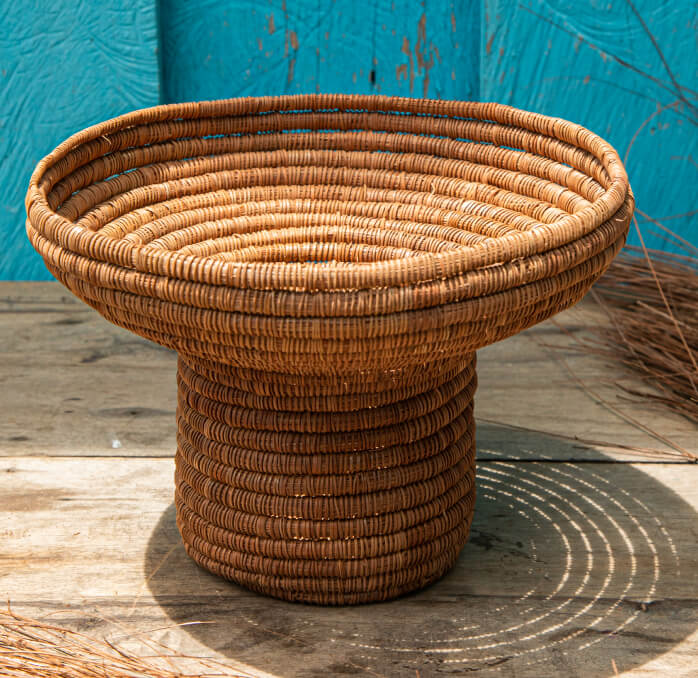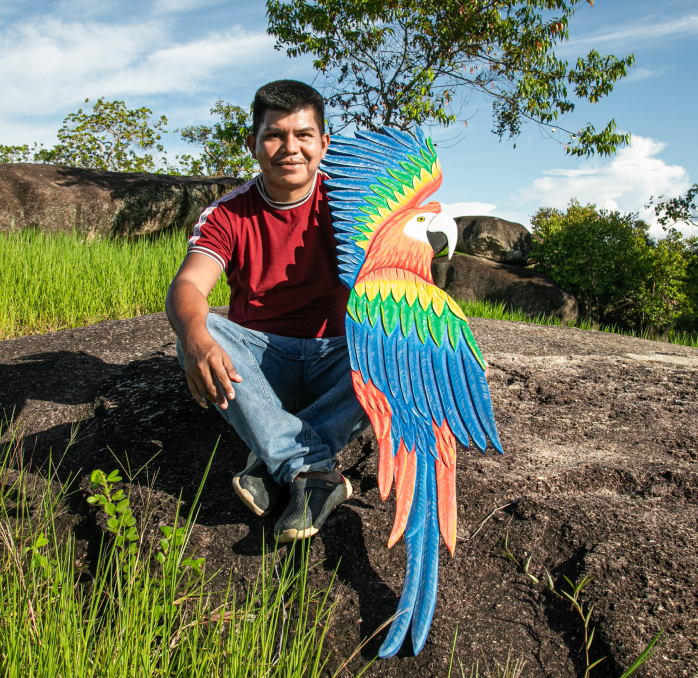Ana Gladys Aponte
Workshop: Zarikana
Craft: Cestería
Trail: Guainía Route
Location: Inírida, Guainía
Ana Gladys’ workshop bears the name of a spider, the zaricana. In the Curripako Piunave language, it signifies the widow spider, who finds it shelter within the chiquichiqui palms thriving in Guainía’s rainforests. Naturally, for a weaver, invoking the spider, the maestro of threads and a symbol of thought, is common. Similarly, Ana Gladys, following in the footsteps of her mother and grandmother, learned this art as tradition dictates among women in her indigenous community—during the onset of puberty.
In the past, girls entering puberty underwent a month-long seclusion, where they were taught the craft of weaving essential kitchen tools: catumare baskets, sifters, graters, and sebucanes—used in processing bitter cassava for making mañoco and casabe. Their heads and eyebrows were shaved during this time. Only a designated indigenous authority could join them and oversee their transition into puberty, undergoing preparations himself: prayer, abstaining from fish, and refraining from conjugal relations. Though Ana Gladys experienced a two-week seclusion, she vividly recalls losing a considerable amount of weight during that period. Her mother, on the other hand, underwent the complete month-long seclusion.
Her community resides near the riverbank of the Inírida River, renowned for its shores frequently visited by tourists. Ana Gladys herself lives deeper in the rainforest, near a stream where she and her family bathe and launder their belongings.
The chiquichiqui palm is an integral part of their culture and daily life, providing fibers for crafting traditional Curripako objects. Ana Gladys elucidates that their homes’ ceilings are covered with its leaves, its fruit juice used in making chicha, and its vines suitable for crafting items like brooms. She explains that men handle the harvesting of the raw material, vigorously shaking the palms in the rainforest since they often house insects, spiders, ants, and snakes. Once the 10-kilo bundles are brought home, women take charge of washing and preparing the fibers, a labor-intensive task.
She reminisces about a group of tourists in 1995 who highlighted the beauty and decorative potential of their creations. They placed an order for pieces that later propelled them into becoming renowned artisans, aided by a design course offered at their indigenous reservation.
Curripako baskets indeed exude beauty, showcasing voluminous structures with sturdy bases. Crafted from chiquichiqui fibers, cut into three-meter-long or 40-centimeter-long strips, shorter ones are used for filling while longer ones are woven with the aid of essential tools: a needle and scissors. Initially woven in their natural brown hue, efforts to dye them were unsuccessful until a community member experimented by burying them in mud for months, resulting in black-dyed fibers. Presently, they combine black and brown hues, offering more versatility in their creations.
Ana Gladys collaborates with 14 women, comprising sisters, aunts, and sisters-in-law—a skilled cohort adept in handling this demanding fiber. This resilient material, sharp and challenging to work with, often leaves their hands injured and bleeding during the learning process. Yet, these seasoned artisans, accustomed to its challenges, possess the know-how regarding the necessary humidity to render the fibers flexible and workable. They communicate through their hands, staunch in their belief that no amount of pain is too great when creating such exquisite beauty.
Craft














Artisans along the way
Artisans along the way
No puede copiar contenido de esta página


























































